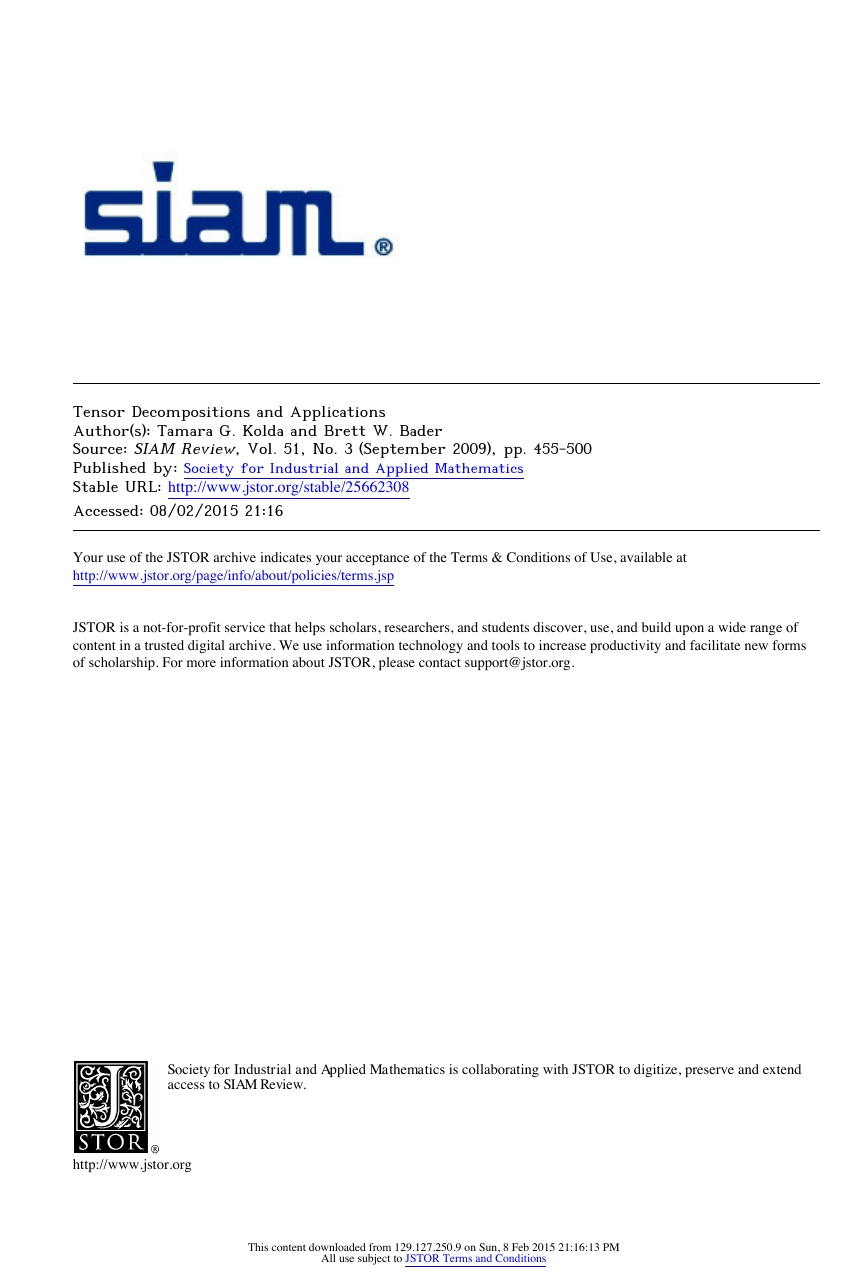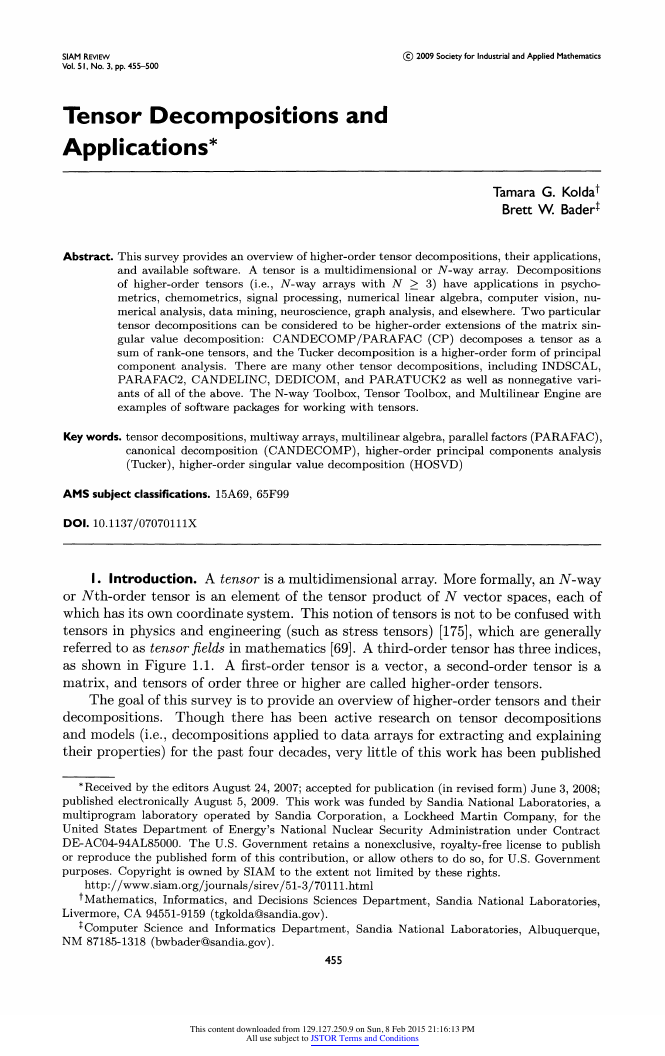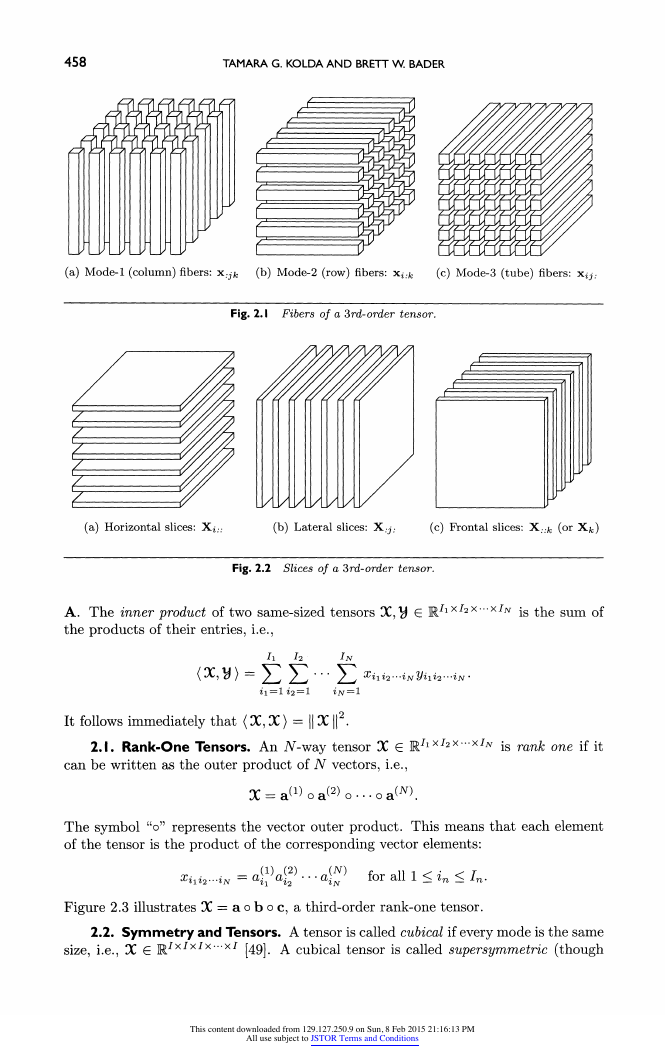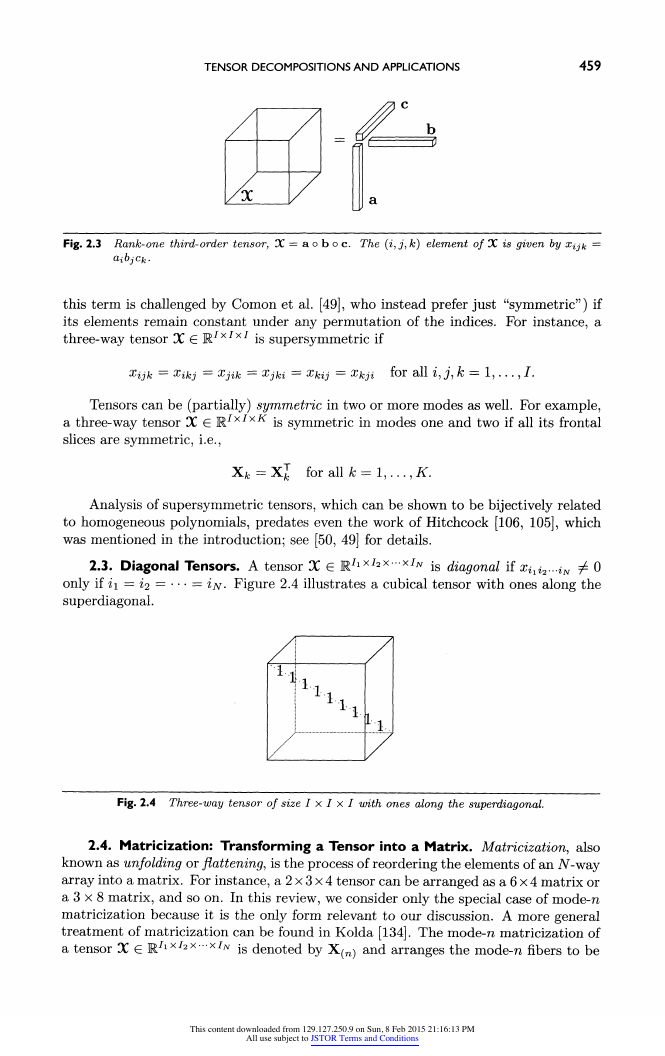Tensor Decompositions and Applications
Author(s): Tamara G. Kolda and Brett W. Bader
Source: SIAM Review, Vol. 51, No. 3 (September 2009), pp. 455-500
Published by: Society for Industrial and Applied Mathematics
Stable URL: http://www.jstor.org/stable/25662308 .
Accessed: 08/02/2015 21:16
Your use of the JSTOR archive indicates your acceptance of the Terms & Conditions of Use, available at .
http://www.jstor.org/page/info/about/policies/terms.jsp
.
JSTOR is a not-for-profit service that helps scholars, researchers, and students discover, use, and build upon a wide range of
content in a trusted digital archive. We use information technology and tools to increase productivity and facilitate new forms
of scholarship. For more information about JSTOR, please contact support@jstor.org.
.
Society for Industrial and Applied Mathematics is collaborating with JSTOR to digitize, preserve and extend
access to SIAM Review.
http://www.jstor.org
This content downloaded from 129.127.250.9 on Sun, 8 Feb 2015 21:16:13 PM
All use subject to JSTOR Terms and Conditions
�
Vol. 51, No. 3, pp. 455-500
SIAM review (c) 2009 Society for Industrial and Applied Mathematics
Tensor Decompositions
Applications*
and
Tamara G. Kolda*
Brett W. Bader*
Abstract.
tensor decompositions,
tensors
survey provides
software. A tensor
an overview of higher-order
is a multidimensional
(i.e., AT-way arrays with N
numerical
chemometrics,
signal processing,
analysis, data mining, neuroscience,
This
and available
of higher-order
metrics,
merical
tensor decompositions
gular value decomposition:
sum of rank-one
component
PARAFAC2,
ants of all of the above. The N-way Toolbox,
examples
tensors, and the Tucker decomposition
of software packages
are many
DEDICOM,
CANDECOMP/PARAFAC
can be considered
CANDELINC,
analysis.
There
for working with tensors.
and PARATUCK2
graph analysis,
to be higher-order
Tensor Toolbox,
or N-w&y
3) have
>
linear algebra,
their applications,
array. Decompositions
applications
computer
in psycho
vision, nu
and elsewhere. Two particular
sin
a tensor as a
of the matrix
extensions
(CP) decomposes
is a higher-order
form of principal
INDSCAL,
including
as well as nonnegative
and Multilinear
Engine
vari
are
other tensor decompositions,
Key words,
tensor decompositions, multiway
canonical
decomposition
arrays, multilinear
algebra, parallel factors (PARAFAC),
(CANDECOMP),
higher-order
principal
components
analysis
(Tucker), higher-order
singular value decomposition
(HOSVD)
AMS
subject classifications.
15A69, 65F99
DOI.
10.1137/07070111X
I. Introduction. A tensor is a multidimensional
array. More formally, an N-way
or TVth-order tensor is an element of the tensor product of N vector spaces, each of
which has its own coordinate system. This notion of tensors is not to be confused with
tensors in physics and engineering (such as stress tensors) [175], which are generally
referred to as tensor fields in mathematics
[69]. A third-order tensor has three indices,
as shown in Figure 1.1. A first-order tensor is a vector, a second-order tensor is a
matrix, and tensors of order three or higher are called higher-order tensors.
The goal of this survey is to provide an overview of higher-order tensors and their
there has been active research on tensor decompositions
decompositions.
and models
applied to data arrays for extracting and explaining
their properties) for the past four decades, very little of this work has been published
(i.e., decompositions
Though
*
Received
published
multiprogram
United
DE-AC04-94AL85000.
or reproduce
purposes.
by the editors August
24, 2007; accepted
for publication
electronically August
5, 2009. This work was funded by Sandia National
laboratory
States Department
operated
by Sandia Corporation,
of Energy's National Nuclear
The U.S. Government
retains a nonexclusive,
the published
form of this contribution,
Copyright
is owned by SIAM
to the extent not
.html
/ sirev/51-3/70111
(in revised form) June 3, 2008;
a
for the
Laboratories,
a Lockheed Martin
Security Administration
royalty-free
under Contract
license to publish
or allow others to do so, for U.S. Government
Company,
limited by these rights.
http: / / www.siam.org/journals
Informatics,
'''Mathematics,
Livermore, CA 94551-9159
* Computer
NM 87185-1318
and Decisions
Sciences Department,
Sandia National
Laboratories,
Science
and
(tgkolda@sandia.gov).
Informatics Department,
Sandia National
Laboratories,
Albuquerque,
(bwbader@sandia.gov).
455
This content downloaded from 129.127.250.9 on Sun, 8 Feb 2015 21:16:13 PM
All use subject to JSTOR Terms and Conditions
�
456 TAMARA G. KOLDA AND BRETT W BADER
.
II
:
.J
/__/v
=
j
f
i,...,j
^
Fig.
I.I A third-order
tensor: X eRIXJxK.
in applied mathematics
attention of SIAM readers.
journals. Therefore, we wish to bring this research to the
is attributed to Cattell
[38] and Harshman
[90] in 1970, all of which appeared
Tensor decompositions originated with Hitchcock
in 1927 [105, 106], and the idea
of a multiway model
in 1944 [40, 41]. These concepts received
in the 1960s
[224, 225, 226] and Carroll
scant attention until the work of Tucker
in psychometrics
and Chang
[13] are generally credited as being the first to
literature. Appellof and Davidson
use tensor decompositions
(in 1981) in chemometrics, and tensors have since become
in that field [103, 201, 27, 28, 31, 152, 241, 121, 12, 9, 29], even
extremely popular
spawning a book
in psychometrics
in 2004
and chemometrics, there was a great deal of interest in decompositions
of bilinear
[130, sec. 4.6.4]. The most
forms in the field of algebraic complexity; see, e.g., Knuth
interesting example of this is Strassen matrix multiplication, which is an application
of a 4 x 4 x 4 tensor to describe 2x2 matrix multiplication
of a decomposition
[208, 141, 147, 24].
[200]. In parallel to the developments
In the last ten years, interest in tensor decompositions has expanded
to other
[62, 196, 47, 43, 68, 80, 173, 60, 61], numer
include signal processing
fields. Examples
[87, 63, 64, 132, 244, 133, 149], computer vision [229, 230, 231, 190,
ical linear algebra
[22, 108, 23, 89, 114, 88, 115], data min
236, 237, 193, 102, 235], numerical analysis
[136, 135, 15], neuroscience
ing [190, 4, 157, 211, 5, 209, 210, 44, 14], graph analysis
[20, 163, 165, 167, 170, 168, 169, 2, 3, 70, 71], and more. Several surveys have been
written in other fields [138, 52, 104, 27, 28, 47, 129, 78, 48, 200, 69, 29, 6, 184], and
a book has appeared very recently on multiway data analysis
there
are several software packages available for working with tensors [179, 11, 146, 85, 16,
17, 18, 239, 243].
Wherever possible, the titles in the references section of this review are hyper
linked to either the publisher web page for the paper or the author's version. Many
format. We also direct the reader to
older papers are now available online in PDF
three-mode bibliography,1 which includes several out-of-print books
P. Kroonenberg's
and theses (including his own [138]). Likewise, R. Harshman's web site2 has many
[90] and Kruskal's
hard-to-find papers,
1989 paper
including his original 1970 PARAFAC
[143], which is now out of print.
The remainder of this review is organized as follows. Section 2 describes the no
tation and common operations used throughout the review; additionally, we provide
pointers to other papers that discuss notation. Both the CANDECOMP/PARAFAC
[139]. Moreover,
paper
1
http://three-mode.leidenuniv.nl/bibliogr/bibliogr.htm
2
http: / /www. psychology, uwo.ca/facuity/harshman
This content downloaded from 129.127.250.9 on Sun, 8 Feb 2015 21:16:13 PM
All use subject to JSTOR Terms and Conditions
�
TENSOR DECOMPOSITIONS AND APPLICATIONS 457
[38, 90] and Tucker
[226] tensor decompositions
(PCA). fn section 3, we discuss the CP decomposition,
can be considered to be higher
(CP)
(SVD) and principal
order generalizations of the matrix singular value decomposition
its con
component analysis
nection to tensor rank and tensor border rank, conditions for uniqueness, algorithms
is covered
and computational
in section 4, where we discuss
its relationship to compression, the notion of n-rank,
Section 5 covers other decom
algorithms and computational
issues, and applications.
positions, including fNDSCAL [38], PARAFAC2 [92], CANDELfNC [39], DEDfCOM
[93], and PARATUCK2
Section 6 provides information
about software for tensor computations. We summarize our findings in section 7.
[100], and their applications.
The Tucker decomposition
issues, and applications.
2. Notation
and Preliminaries.
In this review, we have tried to remain as con
sistent as possible with terminology that would be familiar to applied mathematicians
in the area of tensor decomposi
and with the terminology of previous publications
tions. The notation used here is very similar to that proposed by Kiers
[122]. Other
standards have been proposed as well; see Harshman
and Hong
[96].
[94] and Harshman
The order of a tensor is the number of dimensions, also known as ways or modes.3
(tensors of order one) are denoted by boldface lowercase letters, e.g., a. Matri
Vectors
ces (tensors of order two) are denoted by boldface capital letters, e.g., A. Higher-order
tensors (order three or higher) are denoted by boldface Euler script letters, e.g., X.
Scalars
are denoted
lowercase
a.
letters,
e.g.,
by
The
ith entry of a vector a is denoted by c^, element (i,j) of a matrix A
denoted by a^-, and element (i,j,k) of a third-order tensor X
Indices typically range from 1 to their capital version, e.g., i = 1,...,/.
element in a sequence
is denoted by a superscript in parentheses, e.g., A^
the nth matrix
in a sequence.
is
is denoted by Xijk
The nth
denotes
Subarrays are formed when a subset of the indices is fixed. For matrices, these
are the rows and columns. A colon is used to indicate all elements of a mode. Thus,
the jth column of A
is denoted by
a;;. Alternatively, the jth column of a matrix, a..j, may be denoted more compactly
as dij.
is denoted by a;j, and the ith row of a matrix A
Fibers are the higher-order analogue of matrix rows and columns. A fiber is
defined by fixing every index but one. A matrix column is a mode-1 fiber and a
matrix row is a mode-2 fiber. Third-order tensors have column, row, and tube fibers,
denoted by x;jfc, x^,
extracted from the
tensor, fibers are always assumed to be oriented as column vectors.
and x^;, respectively; see Figure 2.1. When
Slices are two-dimensional
sections of a tensor, defined by fixing all but two
indices. Figure 2.2 shows the horizontal,
lateral, and frontal slides of a third-order
tensor X, denoted by X^...., X^.., and X;;fc, respectively. Alternatively, the kth frontal
slice of a third-order tensor, X;;fc, may be denoted more compactly as X/~.
square root of the sum of the
- x/at ig
The norm of a tensor X G R^x^x
squares of all its elements, i.e.,
wxw =
\ EE-EC
\ 2i=l 22 = 1
*JV = 1
This is analogous to the matrix Frobenius norm, which is denoted
|| A
|| for a matrix
3In some fields, the order of the tensor
is referred to as the rank of the tensor.
literature and this review, however,
the term rank means
something
In much of the
quite different; see section 3.1.
This content downloaded from 129.127.250.9 on Sun, 8 Feb 2015 21:16:13 PM
All use subject to JSTOR Terms and Conditions
�
458 TAMARA G. KOLDA AND BRETT W. BADER
(a) Mode-1
(column)
fibers: x:j-fc
(b) Mode-2
(row) fibers: x^./-
(c) Mode-3
(tube) fibers:
Fig. 2.1
Fibers
of a Srd-order
tensor.
(a) Horizontal
slices: Xj;;
(b) Lateral
slices: X.j;
(c) Frontal
slices: X;;fc
(or Xfc)
Fig. 2.2
Slices
of a Srd-order
tensor.
inner product of two same-sized tensors X,y G ^ix/2x
- x/jv ^s ^ne sum Qf
A. The
the products of their entries, i.e.,
h
In
=
(X,y)
^2
i7V = l
It follows immediately that (X, X) = || X ||2.
ii =1 22 = 1
Ii
Xi1i2...iNyi1i2...iN.
2.1. Rank-One Tensors. An Af-way tensor X e ^^^x-x/iv
can be written as the outer product of N vectors, i.e.,
js mn? one jf ^
^aWoaP'o.-oaC)
The symbol "o" represents the vector outer product. This means that each element
of the tensor is the product of the corresponding vector elements:
for all 1 < in < In.
Figure 2.3 illustrates X = a o b o c, a third-order rank-one tensor.
xili2...iN =
a^a^f
<4^?
2.2. Symmetry and Tensors. A tensor is called cubical if every mode
is the same
[49]. A cubical tensor is called super symmetric (though
size, i.e., X G ^Ixlxlx--'xl
This content downloaded from 129.127.250.9 on Sun, 8 Feb 2015 21:16:13 PM
All use subject to JSTOR Terms and Conditions
�
TENSOR DECOMPOSITIONS AND APPLICATIONS 459
Z-/
=
0
/
a
Fig. 2.3 Rank-one
third-order
tensor, X = aoboc.
The
(i,j,k)
element of X
is given by x^
=
dibjck.
this term is challenged by Comon et al. [49], who instead prefer just "symmetric") if
its elements remain constant under any permutation of the indices. For instance, a
three-way tensor X G R/x/x/
is supersymmetric if
=
%ijk
%ikj
~
%jik
~~
~
~
%jki
%kij
%kji
for all
i, J1, fc =
1, . . . , -T.
Tensors can be (partially) symmetric in two or more modes as well. For example,
is symmetric in modes one and two if all its frontal
a three-way tensor X G RIxIxK
slices
are
symmetric,
i.e.,
Xk=XTk
forallife = l,...,A\
Analysis of supersymmetric tensors, which can be shown to be bijectively related
[106, 105], which
to homogeneous polynomials, predates even the work of Hitchcock
was mentioned
in the introduction; see [50, 49] for details.
2.3. Diagonal Tensors. A tensor X G R7lX/2X"'x/Ar is diagonal
if xili2...iN ^ 0
= in- Figure 2.4 illustrates a cubical tensor with ones along the
only if ii = i^ ?
superdiagonal.
Fig. 2.4
Three-way
tensor of size I x I x I with ones along
the superdiagonal.
a Tensor
Transforming
2.4. Matricization:
also
known as unfolding or flattening, is the process of reordering the elements of an N-w&y
array into a matrix. For instance, a 2 x 3 x 4 tensor can be arranged as a 6 x 4 matrix or
a 3 x 8 matrix, and so on. In this review, we consider only the special case of mode-n
matricization because
it is the only form relevant to our discussion. A more general
treatment of matricization
[134]. The mode-n matricization of
a tensor X G Rjix/2x-x/jv
and arranges the mode-n fibers to be
can be found in Kolda
js denoted by X(n)
into a Matrix. Matricization,
This content downloaded from 129.127.250.9 on Sun, 8 Feb 2015 21:16:13 PM
All use subject to JSTOR Terms and Conditions
�
460 TAMARA G. KOLDA AND BRETT W BADER
the columns of the resulting matrix. Though conceptually simple, the formal notation
is clunky. Tensor element (n, Z2,..., z'at) maps to matrix element (zn, j), where
j=1+Yi(ik
fc = l m=l
~ i^jk with Jk =
N k-1
nim'
The concept is easier to understand using an example. Let the frontal slices of X G
R3x4x2 be
(2.1)
Xi = 2 5 8 11 , X2 =
7
"14
10]
3 6 9 12J
16 19 22"
[13
14 17 20 23 .
L15 18 21 24_
Then the three mode-n unfoldings are
X(1)
'1 4 7 10 13 16 19 22"
= 2 5 8 11 14 17 20 23 ,
(_3 6 9 12 15 18 21 24
_
(2)
13 14 15"
16 17 18
2
'1
4
5
7 8
10 11 12 22 23 24
3
6
9 19 20 21 '
^
_ [1
~
2 3 4
5
|_13 14 15 16 17
9 10 11 12'
21 22 23 24
*
Different papers sometimes use different orderings of the columns for the mode-n
unfolding; compare the above with [63] and [122]. In general, the specific permutation
see
of columns is not important so long as it is consistent across related calculations;
[134] for further details.
Last, we note that it is also possible to vectorize a tensor. Once again the ordering
of the elements is not important so long as it is consistent. In the example above, the
vectorized version is
=
vec(X)
"1"
2
_24_
2.5. Tensor Multiplication:
The n-Mode Product. Tensors can be multiplied
together, though obviously the notation and symbols for this are much more complex
see, e.g., Bader and
than for matrices. For a full treatment of tensor multiplication
i.e., multiplying a
Kolda
tensor by a matrix
The n-mode (matrix) product of a tensor X G Ri"ix/2x-- x/JV witn a matrix U G
x IN.
[16]. Here we consider only the tensor n-mode product,
(or a vector) in mode n.
jTn_i x J x In+1
is of size h
is denoted
RJxIn
xn U
and
x
x
x
by X
Elementwise,
we have
(X Xn
U)-i...-ri_ij
=
in+1...iN
Xii*2-iN
^2
in = l
Ujin'
This content downloaded from 129.127.250.9 on Sun, 8 Feb 2015 21:16:13 PM
All use subject to JSTOR Terms and Conditions
�
TENSOR DECOMPOSITIONS AND APPLICATIONS 461
Each mode-n fiber is multiplied by the matrix U. The
terms of unfolded tensors:
idea can also be expressed in
y = xxnu
&
Y(n)
=
ux(n).
The n-mode product of a tensor with a matrix
case when a tensor defines a multilinear operator.
is related to a change of basis in the
As an example,
let X be the tensor defined above in (2.1) and let U =
[2 4 i]
Then the product y = X xx U G R2x4x2
is
_ [22 49 76
1 ~~
103]
'
[28 64 100 136J
_ [130
2 ~
157 184 211"
[172 208 244 280
*
A few facts regarding n-mode matrix products are in order. For distinct modes
in a series of multiplications,
the order of the multiplication
is irrelevant, i.e.,
lxmAxnB
= lxnB
xrn A
(m^n).
If the modes are the same, then
X x n A x n B =
Xxn(BA).
The n-mode (vector) product of a tensor X G M7* X/2X"'xIn with a vector v G R7n
x In-\ x
is denoted by X xn v. The result is of order N ?
l, i.e., the size is ii x
Jn+i
x
x 1^.
Elementwise,
(X Xn
v)i1...in_1in+1...iN
?
In
in=l
%i1i2--'iN Vin
The idea is to compute the inner product of each mode-n fiber with the vector v.
For example, let X be as given in (2.1) and define v =
[l 2 3 4]
. Then
X x2 v =
'70
190"
80 200
90 210_
.
When
it comes to mode-n vector multiplication, precedence matters because the
order of the intermediate results changes. In other words,
X xm a xn b =
(X xm a) xn_i b =
(X xn b) xm a
for m < n.
See [16] for further discussion of concepts in this subsection.
2.6. Matrix Kronecker, Khatri-Rao,
and Hadamard
Products.
Several matrix
products are important in the sections that follow, so we briefly define them here.
The Kronecker product of matrices A G E/Xj
(g) B. The result is a matrix of size (IK) x (JL) and defined by
and B G RKxL
A
is denoted by
anB
a2iB
....
ai2B
a22B
auB"
a2jB
A<8>B=
=
_a/iB
[ai0bi
a/2B
ai0b2
a/jB
ai 0 b3
aj^b^-i
aj^bz,].
This content downloaded from 129.127.250.9 on Sun, 8 Feb 2015 21:16:13 PM
All use subject to JSTOR Terms and Conditions
�
















 2023年江西萍乡中考道德与法治真题及答案.doc
2023年江西萍乡中考道德与法治真题及答案.doc 2012年重庆南川中考生物真题及答案.doc
2012年重庆南川中考生物真题及答案.doc 2013年江西师范大学地理学综合及文艺理论基础考研真题.doc
2013年江西师范大学地理学综合及文艺理论基础考研真题.doc 2020年四川甘孜小升初语文真题及答案I卷.doc
2020年四川甘孜小升初语文真题及答案I卷.doc 2020年注册岩土工程师专业基础考试真题及答案.doc
2020年注册岩土工程师专业基础考试真题及答案.doc 2023-2024学年福建省厦门市九年级上学期数学月考试题及答案.doc
2023-2024学年福建省厦门市九年级上学期数学月考试题及答案.doc 2021-2022学年辽宁省沈阳市大东区九年级上学期语文期末试题及答案.doc
2021-2022学年辽宁省沈阳市大东区九年级上学期语文期末试题及答案.doc 2022-2023学年北京东城区初三第一学期物理期末试卷及答案.doc
2022-2023学年北京东城区初三第一学期物理期末试卷及答案.doc 2018上半年江西教师资格初中地理学科知识与教学能力真题及答案.doc
2018上半年江西教师资格初中地理学科知识与教学能力真题及答案.doc 2012年河北国家公务员申论考试真题及答案-省级.doc
2012年河北国家公务员申论考试真题及答案-省级.doc 2020-2021学年江苏省扬州市江都区邵樊片九年级上学期数学第一次质量检测试题及答案.doc
2020-2021学年江苏省扬州市江都区邵樊片九年级上学期数学第一次质量检测试题及答案.doc 2022下半年黑龙江教师资格证中学综合素质真题及答案.doc
2022下半年黑龙江教师资格证中学综合素质真题及答案.doc